- Department of Nutrition and Food Processing, Al-Huson University College, Al-Balqa Applied University, Al-Huson, Jordan
Introduction: The purpose of this study is to examine the effects of varying proportions of dried-orange-albedo and dried-apple-peel powders in edible coating films for falafel balls on their subsequent oil uptake and sensory properties when used during deep frying in oil.
Methods: Coating solutions of 3%, 5%, and 7% w/v of either orange albedo or apple-peel powder were prepared and heated to 90°C for 5 min, after which they were cooled. In the next step, the falafel-ball samples were air-dried after dipping them in the coating solutions. The falafel balls coated with different solutions were then deep-fried and their oil and moisture content with the calculation of oil uptake and moisture retention was analyzed, along with the evaluation of sensory attributes.
Results: According to the results, oil uptake during deep oil frying was reduced to varying extents in all coating treatments. For both orange albedo and apple-peel powder, the coating films containing 5% of either were found to be the most effective level in reducing the oil uptakes.
Discussions: The coating films prepared from orange albedo reduced oil uptake more than those containing the same amount of apple peel for all levels. All falafel ball samples prepared with the different coatings were found to have improved sensory features compared with the uncoated control.
1. Introduction
Falafel, a fried ball, comprises spiced fava beans and chickpeas (Abdullah, 2015). It is highly popular in the Middle East and North Africa and is becoming increasingly popular throughout the world, especially in Jordan, where it is considered a favorite food by all social and economic classes (Janakat and Al-Khateeb, 2011). The laborers and low-income families consumed falafel daily either for breakfast, dinner, or as a snack because it is readily available, tasty, and relatively low price. Often, this snack is prepared from chickpeas mixed with parsley, garlic, and special spices, which are deep-fried in vegetable oil (Janakat and Al-Khateeb, 2011).
Frying improves the texture, flavor, and appearance of food after frying; therefore, it is appreciated globally. Moreover, different fried foods like fried chicken, onion rings, French fries, and nuggets are served by global fast-food companies. However, a significant concern with fried food is the high oil content, which can contribute to health issues such as high cholesterol, high blood pressure, and obesity. In addition, frying can generate various oxidation byproducts that have been linked to diseases such as membrane damage, premature aging, heart disease, and cancer. As a result, consuming fried foods has become a significant health concern (Jerónimo and Alves, 2022). Health organizations and media outlets advocate reducing the proportion of oil in the average diet. One of the main motivations behind current research on reducing the oil content of fried food is the desire to create healthier products with less oil absorbed during the frying process. This has resulted in the creation of various methods to reduce the amount of oil in fried food (Angor, 2016; Ajo, 2017). Several strategies are effective in decreasing the amount of oil absorbed by fried food. One approach to achieve this is to apply an edible film made from an aqueous solution to the food before frying. This coating creates a barrier that prevents moisture loss and reduces the amount of oil absorbed during frying. As a result, the use of coatings is a promising approach for lowering the oil content of fried foods.
The albedo, a white spongy layer of tissue, makes up the majority of citrus peel. It is rich in bioactive compounds such as flavonoids and vitamin C, which have antioxidant properties and can promote good health (Pérez-López and Carbonell-Barrachina, 2005). Orange peels are a common byproduct of the citrus industry and can contribute to environmental pollution if not properly disposed of. However, orange peels are high in carbohydrates, pectin, and fiber, which give them functional properties. As a result, they can be used in various applications (Abou-Arab et al., 2019).
Normally, when apple peel is produced as a byproduct, it is directly disposed of as waste. The peel of apples contains high levels of phenolic compounds, which have anti-oxidant and anti-proliferative properties (Wolfe and Liu, 2003). These compounds, along with dietary fiber, have been shown to have various in vitro bioactive effects, such as potentially reducing the risk of coronary heart disease (Massini et al., 2013). There is increasing interest in using natural additives, particularly dietary fibers, as potential antioxidants in various industrial applications, particularly in the fields of cosmetics and food preservation. These fibers are appealing for technological and functional properties, along with their nutritional properties (Pérez-López and Carbonell-Barrachina, 2005). The aim of this study is to assess the effects of using different proportions of orange albedo and apple-peel powder as coating-material films for falafel balls on their oil uptake and sensory properties when used during deep oil frying.
2. Materials and methods
The falafel dough was purchased from the local market. Falafel balls were manually formed using a special ladle, frozen at −18°C for 2 h, and fried as described below.
The coating materials used were apple peel and orange albedo orange powders that were prepared by drying orange albedo and apple peel at 37 ± 2°C in an air oven for 72 h followed by subsequent grinding of the dried peels and sieved to obtain particle sizes of 150 μm (Fernández-Ginés et al., 2003).
2.1. Preparing coating-solution
Six solutions of 3, 5, and 7% w/v were made to prepare each coating material (pre-treatments were conducted to choose the percentage). The solutions were heated for 5 min to 90°C and then cooled at room temperature. Afterward, 3% w/v of glycerol was added to the solutions as a plasticizer. The frozen falafel balls were quickly dipped into the coating solutions for 5 s and then air-dried using a fan. This process was repeated to ensure that the film was evenly coated on the product. Uncoated falafel balls were used as controls.
2.2. Frying
An electrical deep- oil fryer was used to fry the coated and uncoated samples using sunflower oil for 3 min at 180 ± 5°C. The temperature and time were controlled using a digital thermocouple. This frying resulted in formation of a golden surface. The oil was replaced for each different coating solution after two batches of frying. Ten falafel balls were placed in the frying basket for each batch, and the basket was immersed in the oil to fry the samples. After frying, the samples were placed on absorbent tissue paper for 10 min to remove excess oil before testing. A portion of the freshly fried samples was used for sensory evaluation immediately, while the remaining samples were stored in plastic bags until needed for chemical and physical analysis. All experiments were performed in triplicate, and the results shown are the average of the obtained results.
2.3. Proximate analysis
After frying, samples were analyzed for moisture and oil content according to AOAC (2000) in triplicate. The oil and moisture data were compared by calculating the percent relative variation in oil uptake (OU%) and moisture retention (MR%) in the coated product compared to the uncoated product, using the following formula stated by Angor (2014):
2.4. Sensory assessment
The sensory quality of the falafel samples was evaluated by a panel of 50 semi-trained individuals selected from the students and staff of the Department of Nutrition and Food Processing at Al-Huson University College. The panel consisted of both male and female participants of various ages who were familiar with falafel products. The samples were randomly coded and individually presented to the panelists for evaluation of sensory attributes (appearance, flavor, color, crispiness, taste, and overall acceptability) for desirability according to the five-point hedonic scale described by Belmes (2018), varying from 5 (like extremely) to 1 (dislike extremely). The taste between testing of samples was neutralized using pieces of bread and water. No information about the sample treatments was given to the panelists, and they were not offered any incentives to participate to avoid bias.
2.5. Data analysis
Data analysis for this study was conducted with the help of Statistical Analysis Software (SAS, 2003). The data obtained were analyzed using a completely randomized design (CRD). A significant difference between data means was estimated using the least significant difference test at p-value < 0.05.
3. Results and discussion
The oil and moisture content of the falafel balls coated with different levels of dried-orange-albedo powder is shown in Table 1. The data show that for all levels of dried orange albedo used, the oil content was effectively reduced and the moisture-content percentage increased compared with the uncoated sample (C).
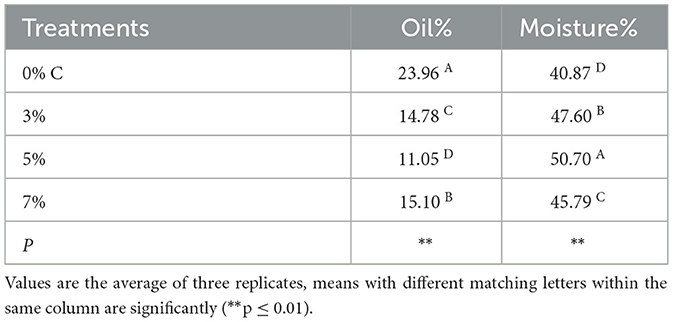
Table 1. Oil and moisture contents of different levels of orange-albedo powder as coating films for deep-fried falafel balls.
The oil and moisture percentage for the deep-fried falafel balls coated with films containing different concentrations of dried orange albedo (3, 5, and 7%) and the control ranged from 11.05–23.96% and 40.87–50.70%, respectively.
All the treatments of albedo orange as coating materials significantly (p ≤ 0.05) reduced the oil compared with the control. Of all these treatments, the lowest oil percentage (11.05%) was obtained for the coating film with 5% albedo orange. This result is in agreement with those of Lazaridou and Biliaderis (2020), who, using polysaccharide as a coating formulation, reported that French fries coated with a mixture of CMC (0.5% w/w) and pectin (1% w/w) had lower oil uptake compared to the uncoated sample. In addition, Angor (2014) concluded that using a 5% solution of whey protein isolate as a coating for foods like potato-pellet chips may reduce oil absorption during deep frying. This may be due to the formation of covalent bonds within the film during heating, which can lead to decreased oil absorption.
The results presented in Table 2 show the oil and moisture content of falafel balls coated with films containing different levels of apple peel. The data demonstrate that using any amount of apple peel as a coating was effective at increasing the moisture content and decreasing the oil content in comparison to the control sample (C).
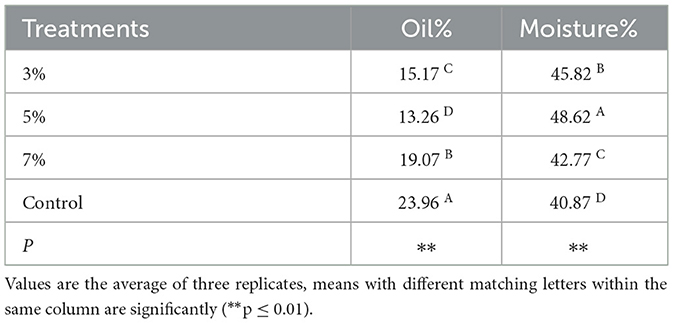
Table 2. Oil and moisture contents of different levels of apple peel as coating film for deep-fried falafel balls.
The oil and moisture percentage in the deep-fried falafel coated with films containing different concentrations of apple peel (3, 5, and 7%) and the control ranged from 13.26–23.96% and 40.87–48.62%, respectively. All the treatments of apple peel as coating materials significantly (p ≤ 0.01) reduced the oil percentage compared with the control. Of all these treatments, the lowest oil percentage (13.26%) was obtained for the coating film with 5% apple peel. Al-Asmar et al. (2019) illustrated that the use of a pectin-based solution resulted in a reduction of the oil content of treated falafel balls to about 23%.
There was an increase in the moisture content of fried falafel balls coated with different concentrations of apple peel with their increasing concentration in the coating. The 5% apple-peel coating resulted in fried falafel balls with the increased level of moisture content. This result is in agreement with those of Al-Asmar et al. (2019), who found that falafel balls treated with a 1% pectin-based solution had significantly increased water content compared with the control. Many researchers have obtained similar results, including Garmakhany et al. (2014) and Mahajan et al. (2014). In addition, Angor (2014) concluded that the use of whey protein or its isolate as a coating on potato-pellet chips can increase the moisture content up to 48.62% compared to uncoated controls. The coating creates a barrier that helps to retain moisture during frying, which may be the reason for the increase in moisture content.
Figure 1 shows the oil-uptake and moisture-retention percentages associated with different levels of orange-albedo powder and apple peel in films used for coating falafel balls during deep frying. The oil uptake is lower in coated samples compared to uncoated samples (c) because the coating reduces the oil content. In this work, the highest oil uptake observed for the orange albedo is (−53.86 ± 0.32), and for the apple peel, it is (−44.65 ± 1.397). These results are in agreement with those of Jafarin and Mohammadnejad (2020) and Liu et al. (2021), who concluded that the use of gum coating reduces the oil absorption of fried products. When using either orange albedo or apple peel in coating films, the most effective reduction in oil uptake of falafel balls was at a level of 5% in both cases.
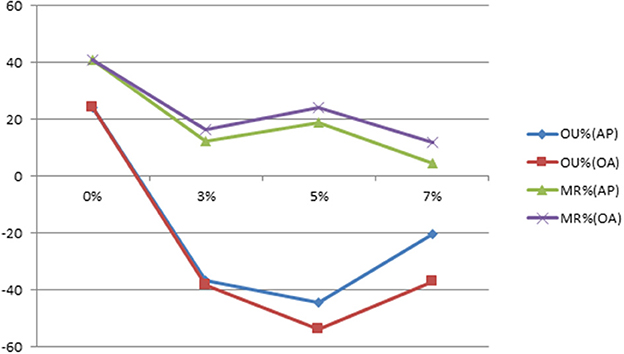
Figure 1. Fat uptake OU% and moisture retention MR% of control and samples coated with coating films containing different concentrations of orange albedo (OA) and apple peel (AP) in the preparation of deep-fried falafel balls.
The impact of different treatments of orange albedo and apple peel as coating films on the reduction in oil absorption led to increased retention of moisture in the deep-fried falafel balls. Coated samples had higher moisture content than uncoated samples (controls), resulting in positive moisture retention for each coating film made of orange albedo or apple peel. This trend continued until the concentration reached 5%. Angor (2016) found that the formation of a protective film on the surface of samples during the early stages of frying due to thermal gelation led to a reduction in oil uptake and an increase in moisture retention.
Oil absorption is determined by the food's moisture content because the vapor generated during heating leaves voids into which oil can subsequently enter (Oke et al., 2018). However, the orange-albedo and apple-peel films form a layer of gel, which reduces the penetration of oil and, thus, the evaporation of water. The orange-albedo-coating films reduced oil uptake to a greater extent than the apple peel for all corresponding treatments. Angor (2016) reported the effectiveness of pectin in reducing oil content when used as a component of coatings.
The material's sensory characteristics being marketed attract the consumers. The control (uncoated) and deep-fried falafel balls' overall acceptability prepared using orange-albedo and apple-peel coating films were determined according to a five-point hedonic scale for appearance, color, crispiness, taste, texture, and flavor with results shown in Figures 2, 3, respectively.
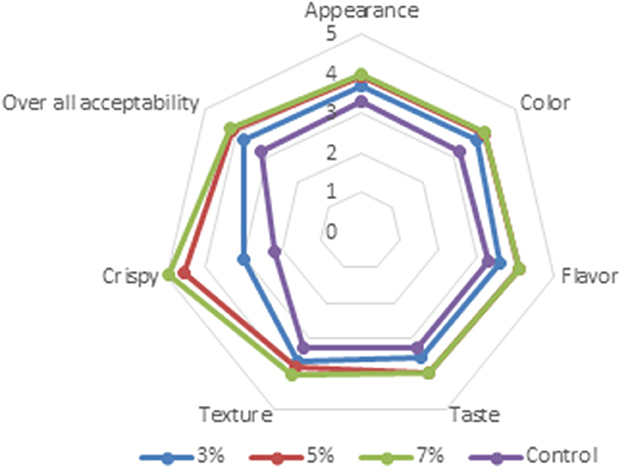
Figure 2. Spider plot of the sensory-evaluation scores of different levels of orange albedo as coating films for deep-fried falafel balls.
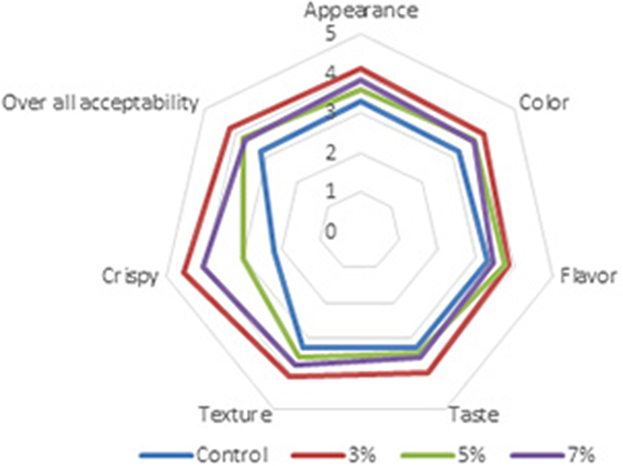
Figure 3. Spider plot of the sensory-evaluation scores of different levels of apple peels as coating films for deep-fried falafel balls.
All coating treatments (orange albedo and apple peel) improved all sensory-attributes scores compared with the uncoated treatment (control). Figure 3 has shown the scores for the appearance and color of the samples coated with orange albedo ranging from 3.68–3.96 and 3.76–4.04, respectively, corresponding to the range of like to like very much. This may have been because most people enjoy falafel balls in different ranges of color. No significant differences was observed between the treatments, and the scores for these treatments were higher than the control.
The other attribute scores, crispiness, taste, and flavor of the samples coated with orange albedo were in the ranges of 3.6–4.12, 3.52–3.96, and 3.64–4.00, respectively (Figure 2). The figure represents the mean sensory profile based on the 5-point rating scale, where 5 refers to like extremely and 1 refers to dislike extremely. There were no significant differences (p ≤ 0.05) between the treatments, and the scores for these treatments were higher than those of the control. Mohamed and Mohamed (2018) reported that coating treatments improved the sensory attributes of potato chips compared with uncoated treatments.
The overall acceptability scores for samples coated with orange albedo ranged from “like” to “like very much” (as shown in Figure 2), while the uncoated sample had a lower overall acceptability score compared to all the coated treatments. However, the differences in overall acceptability between the various treatments of falafel balls were minor. These results are in agreement with those of Angor (2016) and Ajo (2017), who found that edible coating films can improve the sensory attributes of French fries compared to uncoated samples. The highest scores for all sensory attributes were achieved using a 5% concentration of orange albedo as a coating film.
Figure 3 represents the mean sensory profile based on the 5-point rating scale, where 5 refers to like extremely and 1 refers to dislike extremely. The overall acceptability scores for samples coated with apple peel ranged from “like” to “like very much” (as shown in Figure 3). The lowest overall acceptability score was determined for uncoated sample, unlike all the coated treatments. However, there were minor differences in overall acceptability between the different treatments of falafel balls. These results conform to those of Tak and Jain (2019), who found that uncoated and coated samples were almost equally acceptable based on sensory-scores since no significant difference was noted between the control and treatment samples. In our study, the sensory characteristics of deep-fried falafel balls that had been coated with apple-peel film treatments (Figure 3) had nearly the same trend as those coated with orange-albedo films.
4. Conclusions
Coating falafel balls with dried orange albedo or apple-peel powder in various concentrations can reduce oil absorption while deep frying. The most effective level of reduction in oil uptake was −53.86% for the orange albedo and −44.65% for apple peel when included at a level of 5% in films in both cases. The orange-albedo coating films reduced the oil uptake to a greater extent than the apple peel when comparing the same amount for all levels. It is important to evaluate the sensory qualities of food products. In this study, coating falafel balls with dried orange albedo or apple-peel powder improved all sensory features compared to the uncoated control.
Data availability statement
The original contributions presented in the study are included in the article/supplementary material, further inquiries can be directed to the corresponding author.
Author contributions
The author confirms being the sole contributor of this work and has approved it for publication.
Acknowledgments
The author is thankful to all the associated personnel who contributed to this study by any means.
Conflict of interest
The author declares that the research was conducted in the absence of any commercial or financial relationships that could be construed as a potential conflict of interest.
Publisher's note
All claims expressed in this article are solely those of the authors and do not necessarily represent those of their affiliated organizations, or those of the publisher, the editors and the reviewers. Any product that may be evaluated in this article, or claim that may be made by its manufacturer, is not guaranteed or endorsed by the publisher.
References
Abdullah, T. (2015). Reduction of oil uptake in deep fat fried falafel. J. Nutr. Health Food Eng. 2, 114–117. doi: 10.15406/jnhfe.2015.02.00059
Abou-Arab, E., Mahmoud, M., and Abu-Salem, F. (2019). Functional properties of citrus peel as affected by drying methods. Am. J. Food Technol. 12, 193–200. doi: 10.3923/ajft.2017.193.200
Ajo, R. Y. (2017). Application of hydrocolloids as coating films to reduce oil absorption in fried potato chip-based pellets. Pak. J. Nutr. 16, 805–812. doi: 10.3923/pjn.2017.805.812
Al-Asmar, A., Giosafatto, V., Panzella, L., and Mariniello, L. (2019). Improving the Health Quality of Fried Falafel (Middle Eastern Food) by Using Transglutaminase and/or Pectin Coating, In Proceedings of the 1st Coatings and Interfaces Web Conference (CIWC 2019). Available online: https://sciforum.net/conference/ciwc2019 (accessed March 15–29, 2019).
Angor, M. (2014). Application of whey protein and whey protein isolate as edible coating films on potato pellets chips to reduce oil uptake deep frying. Contemp. Eng. Sci. 7, 1839–1851. doi: 10.12988/ces.2014.410194
Angor, M. (2016). Reducing oil content of fried potato pellet chips using carboxylmethyl cellulose and soy protein isolate solutions as coating films. J. Agric. Sci. 3, 162–168. doi: 10.5539/jas.v8n3p162
AOAC (2000). Official Methods, AOAC of Analysis, 17th Edn. Washington, DC: Association of Official Analytical Chemists.
Belmes, N. J. (2018). Batuan (Garciniabinucao) fruit preservation. J. Phys. Conf. Ser. 1254, 012030. doi: 10.1088/1742-6596/1254/1/012030
Fernández-Ginés, J., Fernández-López, J., Sayas-Barberá, E., Sendra, E., and Pérez-Alvarez, J. (2003). Effect of storage conditions on quality characteristics of bologna sausages made with citrus fiber. J. Food Sci. 68, 710–714. doi: 10.1111/j.1365-2621.2003.tb05737.x
Garmakhany, D. A., Mirzaei, H. O., Maghsudlo, Y., Kashaninejad, M., and Jafari, S. M. (2014). Production of low-fat French-fries with single and multilayer hydrocolloid coatings. J. Food. Sci. Technol. 51, 1334–1341. doi: 10.1007/s13197-012-0660-9
Jafarin, S., and Mohammadnejad, P. (2020). Effect of propolis coating on oil uptake and quality properties of fried potato (Solanum tuberosum) strips. Asian Food Sci. J. 15, 18. doi: 10.9734/afsj/2020/v15i130139
Janakat, S., and Al-Khateeb, M. A. (2011). Effect of a popular middle eastern food (falafel) on rat liver. Toxicol. Environ. Chem. 2, 360–369. doi: 10.1080/02772248.2010.526611
Jerónimo, E., and Alves, S. P. (2022). “Lipid-derived oxidation products,” in Food Lipids, Sources, Health Implications, and Future Trends, eds J. M. Lorenzo, M. Pateiro, R. Domínguez, P. E. Munekata, F. Barba (Cambridge, MA: Academic Press).
Lazaridou, A., and Biliaderis, C. G. (2020). “Edible Films and Coatings with Pectin,” in Pectin: Technological and Physiological Properties, eds, V. Kontogiorgos (Berlin/Heidelberg: Springer).
Liu, Y., Tan, J., Duan, Z., Li, J., and Fan, L. (2021). Effect of oil surface activity on oil absorption behavior of potato strips during frying process. Food Chem. 365, 130427. doi: 10.1016/j.foodchem.2021.130427
Mahajan, I., Sonka, C., and Surendar, J. (2014). Study on the effective reduction of oil up-take by the application of edible hydrocolloid coatings on French fries. Int. J. Eng. Sci. Adv. Technol. 2, 1–7. Available online at: http://www.ijreat.org/Papers%202014/Issue9/IJREATV2I3056.pdf
Massini, L., Rico, D., Diana, A., and Barry-Rayan, C. (2013). Valorisation of apple peels. Eur. J. Food Res. Rev. 3, 1–15. doi: 10.21427/D7R32T
Mohamed, E., and Mohamed, S. M. (2018). Effect of coating material on the quality of oil uptake and potato chips. Egypt J. Food Sci. 46, 83–90.
Oke, E., Idowu, M., Sobukola, O., Adeyeye, S., and Akinsola, A. (2018). Frying of food: a critical review. J. Culin. Sci. Technol. 16, 1–21. doi: 10.1080/15428052.2017.1333936
Pérez-López, A., and Carbonell-Barrachina, A. (2005). Fiber content in the edible portion of eight mandarin oranges cultivars. J. Food Qual. 28, 154–162. doi: 10.1111/j.1745-4557.2005.00015.x
Tak, J., and Jain, S. (2019). Effect of edible coatings on fat absorption of french-fries. Int. J. Chem. Stud. 7, 1979–1983.
Keywords: apple-peel powder, coating films, falafel balls, oil, orange-albedo powder
Citation: Angor M (2023) Reducing oil absorption of falafel balls by using edible coating films containing dried orange-albedo powder or dried apple peel during deep frying. Front. Sustain. Food Syst. 7:1156316. doi: 10.3389/fsufs.2023.1156316
Received: 01 February 2023; Accepted: 29 March 2023;
Published: 17 April 2023.
Edited by:
Samuel Ayofemi Olalekan Adeyeye, Hindustan University, IndiaReviewed by:
Emmanuel Oke, Federal University of Agriculture Abeokuta, NigeriaIoanna G. Mandala, Agricultural University of Athens, Greece
Copyright © 2023 Angor. This is an open-access article distributed under the terms of the Creative Commons Attribution License (CC BY). The use, distribution or reproduction in other forums is permitted, provided the original author(s) and the copyright owner(s) are credited and that the original publication in this journal is cited, in accordance with accepted academic practice. No use, distribution or reproduction is permitted which does not comply with these terms.
*Correspondence: Malak Angor, dr.angormalak@bau.edu.jo
 Malak Angor
Malak Angor